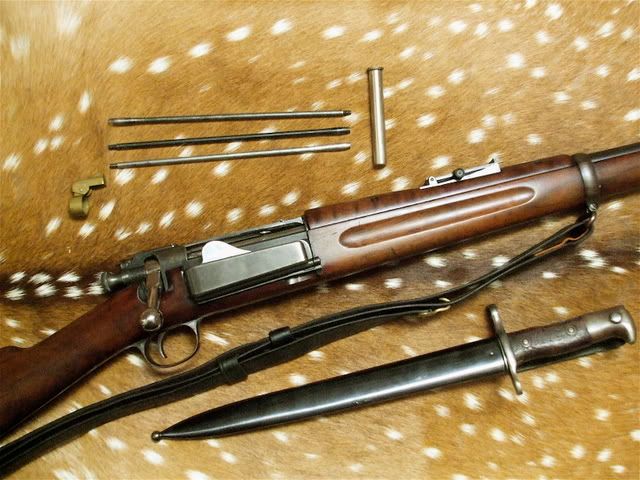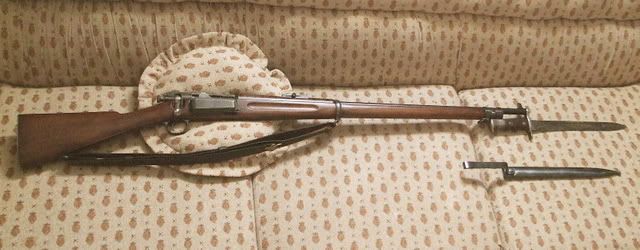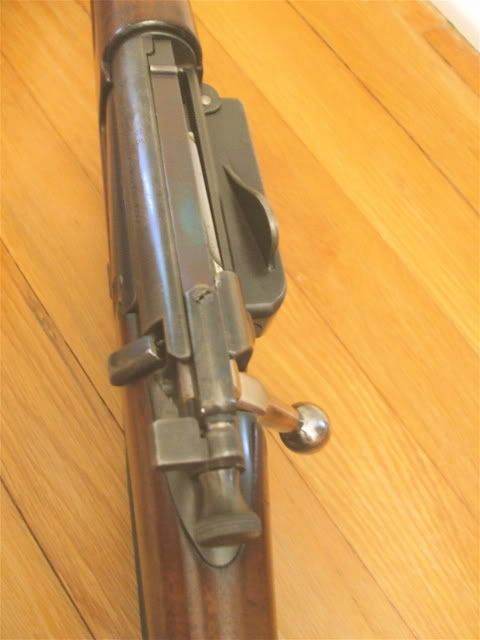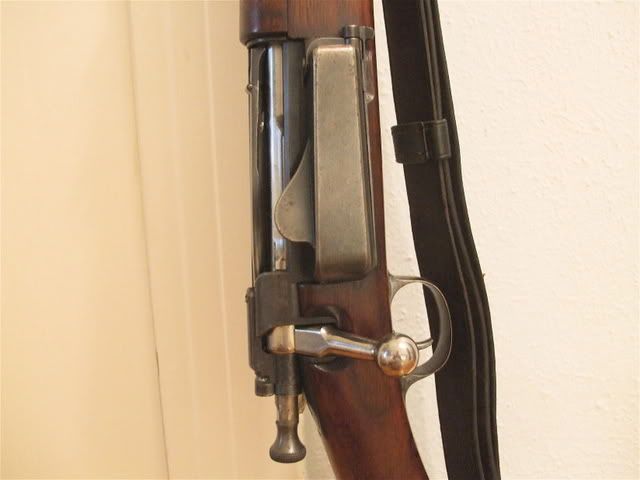Krag Jorgensen .30-40

Heres a sentimental favorite of mine, the .30-40 Krag, an all-American cartridge with a Norwegian delivery system. The .30-40 was the American entry into the growing number of small-bore cartridges fielded by the world powers in the closing decades of the 19th century. This ancient cartridge was effective in its day and still provides useful ballistics in this 21st century.
France led the way in 1886 with an 8mm cartridge loaded with the first viable smokeless propellant. Introduced after trials cloaked in secrecy, this new cartridge development was said to be both smokeless and noiseless. Smokeless it effectively was but if anything it was likely louder than the old Gras rifles which it replaced. It offered higher velocities with attendant trajectory benefits. Germany, Great Britain, and other European powers scrambled to complete developmental work on concepts they were investigating in order to produce high-velocity small-bore cartridges of their own. These new high-tech small-bore cartridges when utilized in repeating rifles offered a tangible advantage to the army so equipped. Frances Lebel and Germanys 1888 (Commission) rifle were tubular magazine repeaters. The more efficient box magazine rifles developed by American James Paris Lee and adopted by Great Britain, the initial box magazine designs provided by German Paul Mauser, and the Mannlicher system of the Austro-Hungarian Steyr rifle effectively rendered the slower loading tube magazine designs obsolete though they only emerged a few years before.
Some ordnance minds of the times both here and abroad were skeptical of these new-fangled high velocity small-bore cartridges and the repeating rifles in which they appeared. Cries of too small to be effective and magazine fed rifles will cause troops to waste ammunition rose from some quarters. Theres nothing new under the sun and arguments about .223/5.56NATO vs. ammunition using heavier projectiles of larger diameter are only the latest round in the continuing controversy over equipping soldiers with the best possible small arms. Yours truly opines that .22 bore military cartridges are too small and our own soldiers would be better served with something in the 6.5mm to .30 caliber range so likely fits in the group of those who hinder progress.
The United States was just a few years behind all of this small-bore development and adoption activity among the advanced nations of the world. Hide-bound ordnance department officers, some of whom fought in the Civil War, thought the current Springfield single shot trapdoor rifle and carbine with a large, heavy .45 caliber bullet represented a perfectly good fighting weapon for the soldier. The Indians at Wounded Knee could have certainly considered the Trapdoor an "assault rifle". Despite the resistance from some quarters, cartridge development continued in our own ordnance department in the late 1880s and early 1890s, resulting in the .30-40, developed by 1892 but first fielded in 1894. Various repeating rifle designs had been solicited and evaluated in the search for the best delivery system for the cartridge under development.
Among all the designs accepted for trial came a collaborative effort of Ole Hermann Krag and Erik Jorgensen of Norway which was a bolt-action repeater with a unique side opening box magazine design. Already adopted by Denmark and being favorably considered for adoption by the inventors' native Norway, this repeating design looked promising and, upon further testing, won out over all other comers. The excellent Lee rifle design, which our own ordnance department rejected, served Great Britain well into the 20 century with great distinction. Lees rejection was a shame really as Lee was an American and his concepts made for a really superior bolt-action rifle and one that could accept additional technological improvements as they became available. The stripper clip, 8 to 10 round magazines, and many years later, adaptation to the 7.62 NATO comes to mind.

The Krag-Jorgensen was not a bad design and superior to the rifles adopted by some world armies. It gave a generally good account of itself during its period of standard issue, both in our splendid little war the Spanish American War of 1898 and in several early 20th century police actions. A cursory look at the rifle and cartridge in the context of the era may refute some of the myths and misconceptions about our early small bore military cartridge and its repeating rifle.
The .30-40 holds the distinction of being the first smokeless cartridge developed here. Variously known as the .30 Army or .30 US it predates both the .30-30 and .25-35 which were the first commercial smokeless powder cartridge developments in the U. S.. As originally adopted for service it was loaded with a 220 grain round nosed cupro-nickel bullet to a muzzle velocity of 2200 feet per second. Later the velocity specification was lowered to 2000 feet per second. This was supposedly done to counteract the inconsistent performance of ammunition procured by the Army. Some lots were generating higher velocities and pressures than specified and the Ordnance Department was fearful of battering and wearing the actions. This velocity reduction apparently occurred after the Spanish American War.
The sorry reputation of the .38 Long Colt revolvers in our military service must have rubbed off on the performance of the .30-40 as Ive read several recent accounts that pooh-poohed our .30 rifle round. My view is that this inadequate performance is over-blown. I suppose that the Spaniards and semi-civilized colonial troops that opposed United States troops in the Spanish-American War must have known that one ceases hostilities when struck by a bullet, as the .30-40 was generally highly thought of in after-battle reports from that conflict. Not so with the famous Muslin Juramentados encountered in the Philippines when U. S. troops took over occupation and administration of that archipelago after cessation of hostilities with Spain. These fanatical (read that terrorists) tribesmen would drug themselves up, bind their bodies tightly to retard blood loss, and run amok, attempting to take out as many infidels as possible before their inevitable deaths. Their wicked kris and barongs dripped with the blood of many U. S. soldiers who encountered them while on occupation duty. These encounters provided more of a backdrop for the eventual adoption of .45 caliber handguns for U.S military service than they did for sullying the .30-40s reputation. There were some incidents where these fanatics suffered multiple hits from our rifles and continued their mayhem. Who knows how accurately shots were placed from the rifles in the hands of the troops? Would the 7.62 NATO or .30-06 have been that much more effective against such a determined and bodily fortified enemy? Im of the opinion that the .30-40 was about as effective as small arms could be against such attacks. The .38 Colt? I wouldnt have expected any stopping performance from that handgun.
A myth has been repeated over the years that one reason the Spanish M1893 Mauser rifle was considered better than the Krag was the superiority of its ammunition. Now comparing excellent modern Norma factory 7X57 to Span-Am vintage .30-40 would validate this supposition, however if quoted ballistics of the standard cartridge as used in each rifle in 1898 are used, the .30-40 looks to be marginally more powerful and provides superior ballistics than does the 7mm. The data below assumes a 173-grain jacketed round nose bullet for the 7mm and a 220-grain jacketed round nose for the .30-40. Velocity figures come from Barnes Cartridges of the World and are representative of the military issue ammunition of the era.
7mm w/173 grain bullet: 2093 fps 1673 ft./lbs.
.30-40 w/220 grain bullet: 2200 fps 2364 ft./lbs
Additionally see some other world cartridges as issued in their 1890s configurations.
British .303 w/215 grain bullet: 1970 fps 1850 ft./lbs.
French 8mm Lebel w/232 grain bullet: 1885 fps 1831 ft./lbs.
German 7.9X57 w/226 grain bullet: 2095 fps 2200 ft./lbs.
Austrian 8X50 w/244 grain bullet: 2030 fps 2240 ft./lbs.
Russian 7.62X54 w/210 grain bullet: 2115 fps 2086 ft./lbs
Belgian 7.65X53 w/211 grain bullet: 2130 fps 2150 ft./lbs.
Danish 8X58 w/237 grain bullet: 1968 fps 2041 ft./lbs.
Japanese 8X53 w/238 grain bullet: 1850 fps 1810 ft/lbs.
As adopted in 1894 the .30-40 holds its own against the other cartridges of the day. Since there is really no marked superiority of any one of these cartridges over another, one has to look further to find reasons why the Spanish Mauser was superior to the Krag.
Some reasons the Model 1893 Spanish Mauser could be considered the better service rifle include: ease of field maintenance, a strong double locking lugged bolt, and a larger, sturdier, and simpler extractor design. On the other hand the Krag Jorgensen has a single locking lugged bolt, the bolt handle serving as a safety lug. The Krag extractor is more complicated and doesnt offer as much purchase on the cases rim. In the event of a sticky case it would seem that the camming action of the Krags bolt could pull the extractor through the cases rim though Ive not heard of any instance of this occurring.
One rapid-fire string entailing a reload reveals the primary reason though. The Mauser with its charger loading system may be loaded easily and more rapidly than the Krag which requires insertion of its compliment of cartridges into its horizontal box magazine one round at a time. The Mausers stripper clip aids in controlling the cartridges when executing the reload and also keeps them conveniently straight in the cartridge belt or bandoleer. The stress of handling any repeating rifle on the field of battle would surely render correct and rapid manipulation of its action more difficult. The motion of poking loose rounds into a mechanism would be slower and more likely to induce fumbling which would be frustrating and distressing. Practice with a clip-fed rifle would yield more effective trained use of the arm than would practice single loading a rifle with side-opening magazine.
After the conclusion of hostilities in 1898 efforts were sought to improve loading efficiency of the Krag-Jorgensen, including attempts to adapt a charger loading system to its magazine. This experimentation didnt work out and ultimately the Krag was displaced by the 1903 Springfield with a charger loading system and a new rimless cartridge to facilitate it.
Despite its design limitations the Krag may be loaded rapidly enough to be used in the rapid-fire stages of high-power rifle competition. Ive successfully used mine in local competition and even placed ahead of some decent semi-auto shooters. By laying my five-round reload evenly on the mat beside me I was able flip open the loading gate, scoop them up, and shuffle them in without much effort. So nice and easy on the mat, such a procedure wouldnt work in the field where dirt, mud, and weeds could foul the action. My rifle has the Model 1896 rear sight modification, which is the least effective variation of rear sights used on the U. S. Krags due to lack of horizontal adjustment capabilities, yet it is precise enough if one has good vision. Accuracy of the rifle is really superb and it was wonderful to use in the slow-fire stages, especially prone. I find the stock to be too short and its straight grip is archaic but recoil is manageable and the 30-inch barreled rifle is rock steady in the standing position. The bolt cocks on opening and the action is slick and fast in rapid-fire use.

The action of the Krag Jorgenson is a thing of beauty and was likely a bugger-bear to produce with the many machining operations required to manufacture it. A pristine Krag receiver was oil quenched, giving it a dark, muted, and mottled tone. The bolt was left bright and the large flat extractor is fire blued. The barrel, bands, bayonet lug, and trigger guard exhibit a pleasing dark blue and obviously were prepped and polished with meticulous care. Much is said about the smoothness of the Krag action but one simply must experience its operation to appreciate just how incredibly smooth it is! No other bolt-action design is slicker. The action is made of class C ordnance steel which is a simple carbon steel, as was the 1903 Springfield until 1918. I mentioned the Krag on a forum some years ago and a fellow shot back that... the Krag actions are unsafe with their single locking lug which is prone to crack. If that lug breaks the bolt will come back into your head!... Naah, it wont. This prone-to-crack business has been rumored about and has been in print for years. Ive examined every Krag Ive come across for 30 years and am still waiting to see the first one having a locking lug with a discernible crack. Not saying it couldnt happen but Ive not observed it. In the event that a lug did break the bolt handle will offer a margin of safety, as it would have to break off or be driven through the rear receiver bridge in order to come out of the rifle. P.O.Ackley tested a Krag by grinding the locking lug completely off of its bolt and found that the bolt handle alone would hold the bolt in the action with factory equivalent loads.
The .30-40 afield
In older editions of Cartridges of the World Frank C. Barnes he suggested that: no better deer or elk cartridge exists than the .30-40. He was likely right. With 150 grain or 165 grain handloads for lighter big game and 180 to 220 grain handloads for larger animals the .30-40 could (and has) successfully tackled all North American big game. The .30-40 cartridge could be had in all those weights in factory loadings at one time but the factory 180 grain loading is all Ive seen available for many years.
Ive taken two deer and a black buck with the .30-40. A factory velocity equivalent handload with a 220 grain Sierra round nose bullet was used in all instances as this bullet combination agrees with my rifles sights so well. One whitetail deer represented the longest shot Ive made on a deer with open sights, a little over 200 steps. The deer, struck broadside through both lungs staggered, tried to break into a run but collapsed inside of 30 yards. Of course the bullet completely penetrated. Id carefully rested the rifle across the hood of a 1969 Ford pickup on my rolled-up coat.
The other whitetail represents the closest shot I ever made on a deer. He was running past me and all of five feet from the muzzle of the long barrel of my Krag when he was flattened by the heavy 220-grain slug. I was walking down a dry creek bed at the bottom of a deep ravine in San Saba County, Texas. My mission had been to drive deer out of the brushy ravine where my hunting buddy could take one from his vantage point on the rim. He moved his position and in the process jumped up a deer from the rim, which fled down into the ravine and almost on top of me.
The Black buck was a non-event, struck as it made an escape from a screen of brush at 40 yards, the bullet passing through diagonally from right hip through the left shoulder. Black buck are small and light-boned and dont offer much to stop a 220 grain bullet.
Handload Performance
A 1-in-10 twist is standard for the rifled bore of rifles chambered in .30-40. This is what allows the .30-40 to stabilize the long heavy .308 diameter caliber bullets, even at modest velocities. The 30-40 case has a nice long neck that accepts the longer .30 caliber bullets. It is easy to handload. The .30-40 can deliver performance on the order of the .300 Savage with lighter 150-180 grain bullets. That means its close enough to the .308 Winchester that a critter wouldnt know the difference. A .30-40 with a 150-grain bullet would be a powerful, flat shooting rifle for deer sized animals. Handloading manuals have steadily watered down published loads for the .30-40 since I began handloading for it. Generally I dont much care for many of the modern handloading manuals and the lighter loads listed for cartridges, but in the case of the .30-40 this seems reasonable. The Krag Jorgensen rifles may up to 118 years old now and the original Winchester Model 1895s can be about the same age. Additionally the Winchester 1895 action is springy and can develop headspace problems with warm loads. I know as I once had a .30-40 Model 1895 that was hard on cases.
Sierra 220 grain round nose soft point: IMR 4895 MV 2228 ME 2408 ES 42
Sierra 220 grain round nose soft point: IMR 4064 MV 2104 ME 2163 ES 28
Sierra 180 grain Matchking SpBT: IMR 4064, MV 2385 ME 2274 ES 49
Speer 165 grain round nose soft point: IMR 4064, MV 2423 ME 2151 ES 60
Remington 150 grain Core-Lokt Sp: IMR 4895 MV 2703 ME 2434 ES 58
Winchester 110 grain Spitzer: IMR 4320, MV 3022 ME 2231 ES 32
Winchester 180 grain round nose factory load: MV 2478 fps ME 2450 ES 54
velocity figures taken with a U.S. Krag Jorgensen with 30-inch barrel
Oehler Model 12 Chronograph.
The first load listed is the load that I use for my Krag shooting. The others are pretty accurate but don't necessarily impact targets at 100 yards in coordination with my rifle's sights. I have an old long-discontinued Lyman 169 grain gas-check bullet mould of spitzer design but didn't have really good luck with the bullets I made up. While moving I turned up an old box of these that I'd handloaded 25 years ago with a mild charge of Unique. Maybe they'll shoot better with age (NOT). A .30-40 could be a bullet caster's delight though with the right bullet.
Krag rifles were available for $1.50 from the Director of Civilian Marksmanship in the interwar years. The famous old early 20th century firm of Bannerman sold a number of Krags as well. Lots of Krags were sporterized with varying degrees of utility, beauty, and safety. Original examples are no longer commonly encountered and are surprisingly pricey. In fact a number of the old sporterized Krags (even the ugly ones) are tagged with fairly high prices and I suppose some are sold. Id view any Krag that had been subject to a cartridge conversion of any kind as suspect with regards to safety. A friend once purchased an old, ugly, sporterized Krag for chump change and restocked it into a beautiful and accurate hunting rifle. If one was to pick up a nicely done Krag sporter one would have a capable hunting rifle and a real conversation piece around the hunting camp. At this point in time please dont cut up a Krag in its original military configuration for a sporter conversion.
Among sporting rifles the famous Winchester Model 1895 was chambered in .30-40 Krag and was the most common .30-40 rifle from a sporting arms manufacturer. Originals in good condition bring good money but reissues have been made available in recent years, which are a bit more affordable. The scarce Remington Lee bolt-action rifle, which barely lasted into the first years of the 20th century, was available in .30-40. A few Winchester High Wall, Remington Rolling Block, and Stevens single shot rifles were chambered in .30-40 but are most unlikely to be encountered.
Ruger gave the .30-40 a chance when it once offered a variation of its popular No. 1 single shot rifle design in .30-40 back in the 70s. Termed the No. 3 rifle, it was also available in .45-70. It was a cute little carbine length rifle and would offer real utility for a handloading hunter who wanted to play with the .30-40.
With all the different .30 cartridges that bracket it the .30-40 seems redundant in the 21st century. Theres no real reason for its continued existence. Many modern .30 rounds and loads offer more pizzazz for the modern shooter with their long or short, fat or belted shapes. Whether they kill game any deader than did the .30-40 those many years ago is open for debate. The hoary old .30-40 should still occupy an honored place in our active .30 caliber cartridge line-up, as it was the FIRST!







